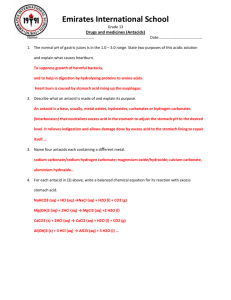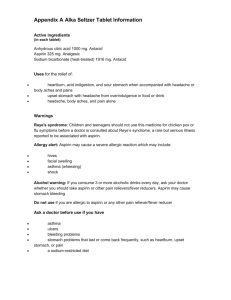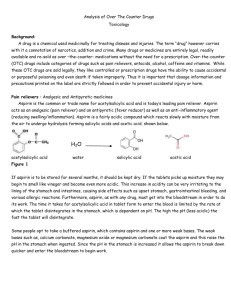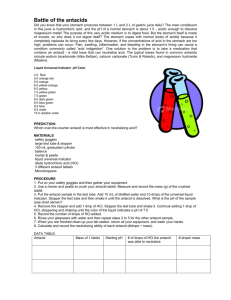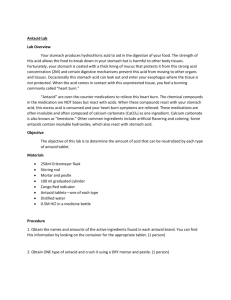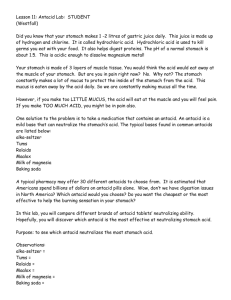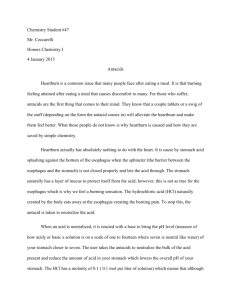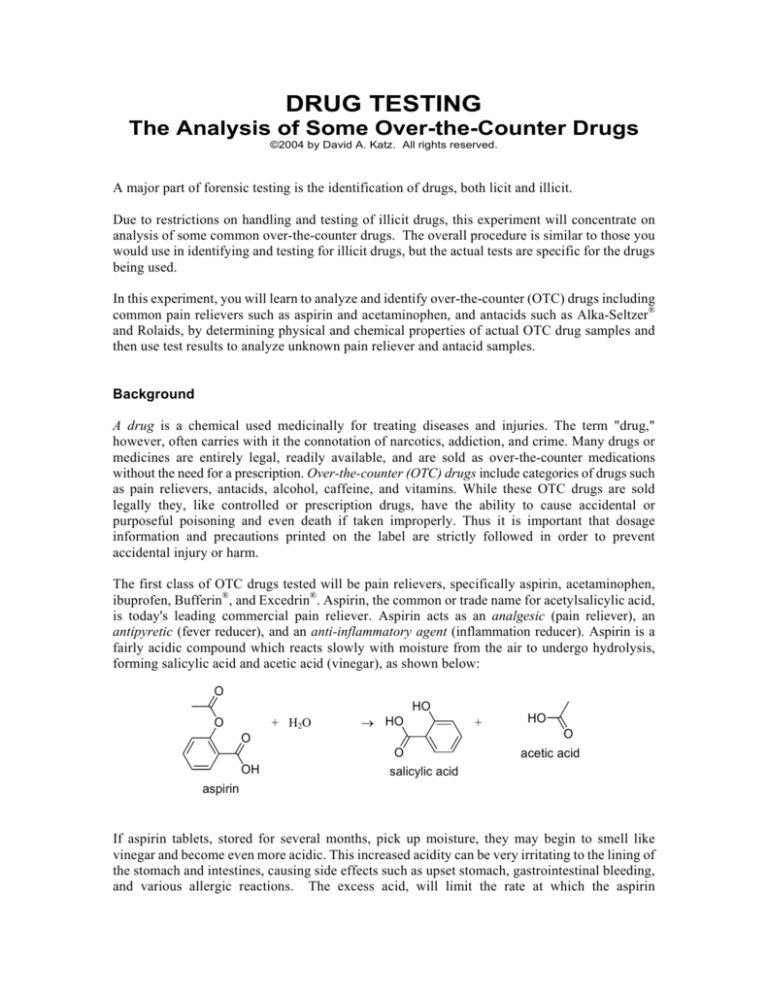
DRUG TESTING
The Analysis of Some Over-the-Counter Drugs
©2004 by David A. Katz. All rights reserved.
A major part of forensic testing is the identification of drugs, both licit and illicit.
Due to restrictions on handling and testing of illicit drugs, this experiment will concentrate on
analysis of some common over-the-counter drugs. The overall procedure is similar to those you
would use in identifying and testing for illicit drugs, but the actual tests are specific for the drugs
being used.
In this experiment, you will learn to analyze and identify over-the-counter (OTC) drugs including
common pain relievers such as aspirin and acetaminophen, and antacids such as Alka-Seltzer®
and Rolaids, by determining physical and chemical properties of actual OTC drug samples and
then use test results to analyze unknown pain reliever and antacid samples.
Background
A drug is a chemical used medicinally for treating diseases and injuries. The term "drug,"
however, often carries with it the connotation of narcotics, addiction, and crime. Many drugs or
medicines are entirely legal, readily available, and are sold as over-the-counter medications
without the need for a prescription. Over-the-counter (OTC) drugs include categories of drugs such
as pain relievers, antacids, alcohol, caffeine, and vitamins. While these OTC drugs are sold
legally they, like controlled or prescription drugs, have the ability to cause accidental or
purposeful poisoning and even death if taken improperly. Thus it is important that dosage
information and precautions printed on the label are strictly followed in order to prevent
accidental injury or harm.
The first class of OTC drugs tested will be pain relievers, specifically aspirin, acetaminophen,
ibuprofen, Bufferin®, and Excedrin®. Aspirin, the common or trade name for acetylsalicylic acid,
is today's leading commercial pain reliever. Aspirin acts as an analgesic (pain reliever), an
antipyretic (fever reducer), and an anti-inflammatory agent (inflammation reducer). Aspirin is a
fairly acidic compound which reacts slowly with moisture from the air to undergo hydrolysis,
forming salicylic acid and acetic acid (vinegar), as shown below:
O
HO
O
+ H 2O
→ HO
O
OH
O
salicylic acid
+
HO
O
acetic acid
aspirin
If aspirin tablets, stored for several months, pick up moisture, they may begin to smell like
vinegar and become even more acidic. This increased acidity can be very irritating to the lining of
the stomach and intestines, causing side effects such as upset stomach, gastrointestinal bleeding,
and various allergic reactions. The excess acid, will limit the rate at which the aspirin
disintegrates in the stomach, since aspirin disintegrates faster at higher pH (less acidic).
For these reasons, some people opt to take a buffered aspirin, which contains aspirin and one or
more weak bases. Bufferin® is a brand of buffered aspirin containing aspirin, calcium carbonate,
magnesium oxide, and magnesium carbonate. The combination of aspirin and weak bases
increases the pH, thus helping with the disintegration of the tablet and hence the absorption of the
acetylsalicylic acid into the blood stream. The weak bases in buffered aspirin reduce the acidity that
results from the hydrolysis of aspirin in the acidic juices of the stomach; thus, buffered aspirin is
found to be less irritating to the stomach lining than aspirin.
The acetylsalicylic acid (aspirin) molecule has an ester side chain group, as shown in the figure
below. The ester group hydrolyzes in the presence of water, leaving an alcohol group (–OH) on the
benzene ring, or a phenol compound. A chemical test to detect the presence of the phenol group is
seen in the reaction with ferric nitrate. When a phenol group is present, a distinct violet-colored
complex is formed. Therefore ferric nitrate is commonly used as a positive indicator test of the
phenol group (and thus for aspirin which easily undergoes hydrolysis).
O
OH
O
O
O
OH
HO
N
H
O
acetaminophen
Ibuprofen
aspirin
Acetaminophen, a non-aspirin headache remedy, is another important OTC pain reliever.
Acetaminophen, which is an acylated aromatic amine as shown in the figure above, is the active
ingredient in Tylenol. Compare the structure of aspirin and acetaminophen and notice the similarities and differences between the chemical structures of the two pain relievers. Notice that
acetaminophen has an alcohol group (–OH) on the benzene ring, also known as a phenol group.
Thus, in the presence of ferric nitrate, a distinct violet-colored complex is produced due to the
reaction of ferric nitrate with the phenol group. Acetaminophen acts as a mild analgesic and
antipyretic, but lacks anti-inflammatory properties. Acetaminophen is a less acidic alternative to
aspirin for those who have an allergic reaction or who find that aspirin produces stomach
disorders. Excedrin is a combination OTC pain reliever, consisting of equal amounts of aspirin
and acetaminophen, and a small amount of caffeine. The caffeine is added as a stimulant to the
nervous system and heart, providing a heightened sense of awareness that some people want in a
pain reliever.
Ibuprofen, another commonly used pain reliever, is the active ingredient in Advil. Ibuprofen,
shown in the figure above, is another non-aspirin OTC drug. However, like aspirin, ibuprofen
acts as an analgesic (pain reliever), an antipyretic (fever reducer), as well as an anti-inflammatory
agent (inflammation reducer). Compare the structures of aspirin, acetaminophen, and ibuprofen
noticing the similarities and differences among the chemical structures of the three molecules.
The second class of OTC drugs tested will be antacids, specifically Alka-Seltzer, Rolaids, and at
least one generic antacid containing calcium carbonate. Antacids are chemicals that relieve
over-acidity by neutralizing excess acid in the stomach. This excess acid can produce discomforts
commonly called "acid indigestion" or "heartburn", and possibly gastric ulcers. Antacids promise
2
to provide "prompt relief' of the unpleasant effects of these stomach distresses. Most antacids will
not dissolve completely in water and are made to dissolve slowly in the acidic juices of the
stomach so that carbon dioxide will be given off gradually as the antacid neutralizes excess acid.
The stomach's digestive juices, or gastric juices, contain hydrochloric acid (HCl), which serves to
promote digestion of food proteins by the enzyme pepsin in the gastric juices and kill bacteria
that enters our digestive system. The stomach lining of a normal adult produces two to three liters
of dilute HC1 each day to aid in digestion, with a normal stomach pH ranging from 1.0 to 3.0.
While the stomach produces a small amount of acid all the time, it can be stimulated to produce
more acid in the presence of food. Too much food, certain types of food, or high levels of stress
may cause the stomach to respond with an outpouring of acid, thus lowering the stomach pH to
the point of discomfort.
Most common antacids contain weak bases such as sodium bicarbonate, calcium carbonate,
magnesium hydroxide, aluminum hydroxide, or various combinations of these. The basic
compounds in the antacids serve to neutralize excess HCI as well as to affect the functioning of
the enzyme pepsin. An acid—base neutralization reaction occurs between the base and the acid in
the stomach. An effective antacid does not bring the pH of the stomach fluid to complete
acid—base neutrality (pH of 7) as this would completely shut down digestion and promote "acid
rebound"—an automatic response which floods the stomach with fresh acid. Instead, an
effective antacid neutralizes some of the HC1 in the gastric juices—enough to relieve the pain
and discomfort, yet still allowing for the continuation of normal digestive processes.
Carbonate-containing antacids, such as sodium bicarbonate, react with stomach acid to produce
a neutral salt and carbonic acid. Carbonic acid is a much weaker acid than HCI and decomposes
readily to yield carbon dioxide and water, as shown below:
NaHCO3 +
HCl →
Sodium
hydrochloric
bicarbonate
acid
H2CO3
carbonic
acid
→
H2CO3 +
carbonic
acid
CO2
NaCl
sodium
chloride
+ H2 O
Hydroxide-containing compounds, such as magnesium hydroxide, react with the acid to
produce its neutral salt and water, as shown below:
Mg(OH)2 + 2 HCl → MgCI2 + 2 H2O
Magnesium
magnesium
hydroxide
chloride
Alka-Seltzer is a popular antacid and pain relief medicine, containing aspirin, citric acid, and
sodium bicarbonate (baking soda). When the tablet is dropped into water, the bicarbonate ions
and the citric acid react, producing the familiar "fizz" from the chemical release of carbon
dioxide. Rolaids is another common antacid, containing a combination of calcium carbonate
and magnesium hydroxide. Other popular antacids, such as Tums, are formulated with only
calcium carbonate. Individuals with high blood pressure are advised to avoid excess sodium
and may choose to use an antacid without sodium bicarbonate. Antacids formulated with
calcium carbonate are advertised as a calcium supplement for people with osteoporosis,
3
however, one would be best advised to use a calcium supplement tablet that does not work as an
antacid if antacids are not needed by an individual. If used over long periods of time, calcium
carbonate tends to cause constipation, thus the reason for antacids containing a combination of
calcium carbonate and magnesium hydroxide. This combination tends to overcome the
constipation as magnesium hydroxide produces an opposite laxative effect. Magnesium
hydroxide, while effective in controlling ulcer pain, has a lower neutralizing capacity and can
cause trouble if taken too frequently by people with kidney impairment. In any case, each OTC
drug must be taken with caution, and dosage information printed on the label should be strictly
followed.
Safety Precautions
Goggles must be worn at all times in the laboratory.
Do not ingest any of the over-the-counter drug samples during this laboratory. The samples are
for laboratory use only, have been stored with other non-food-grade laboratory chemicals, and
are not meant for human consumption.
Hydrochloric acid solution, although it is used in dilute form in this experiment, is toxic by
ingestion and inhalation and is corrosive to skin and eyes. In the event of skin contact, rinse well
with water.
Iron(III) nitrate solution may be a skin/tissue irritant. In the event of skin contact, rinse well with
water.
Universal indicator solution is a flammable, alcohol-based solution. Keep it away from flames.
Materials Needed
Pain reliever tablets:
Acetaminophen tablet
Excedrin® tablet
Aspirin tablet
Ibuprofen tablet
Bufferin® tablet
Unknown pain relievers, powdered
Antacid tablets:
Alka-Seltzer" tablet
Rolaids® tablet
Generic antacid tablet
Unknown antacids, powdered
Distilled or deionized water
Ethanol, C2H5OH, 100%, can use specially denatured ethanol,
Hexane
Hydrochloric acid solution, HCl, 0.5 M
Iron(III) nitrate solution, Fe(NO3)3, 0.2 M
pH indicator paper, wide range 1-12
pH indicator papers, narrow range
Universal indicator solution, with color chart
Water, distilled or deionized, H2O
4
Thin stem Beral pipets
Reaction plate, 48-well
Cotton swabs (for cleaning wells)
Mortar and pestle
Test tubes
Toothpicks (for stirring)
Procedure
Testing Pain Relievers
Obtain a 48-well reaction plate. The plate contains 8 rows of 6 wells.
Obtain an aspirin tablet. Grind it to a powder using a mortar and pestle.
Add a few granules of the powdered aspirin to one six well row. NOTE: Use only a very small
amount of the aspirin powder. Label the row. Reserve the remaining aspirin powder in a small
test tube in case any test needs to be repeated at a later time.
Repeat the procedure using an acetaminophen tablet, placing the powdered acetaminophen in
the second 6 well row.
Repeat the procedure using an Excedrin® or similar tablet, placing the powdered Excedrin in
the third 6 well row.
.
Repeat the procedure using an ibuprofen tablet, placing the powdered ibuprofen in the fourth 6
well row.
Repeat the procedure using a Bufferin® of buffered aspirin tablet, placing the powdered
buffered aspirin in the fifth 6 well row.
Record the brand name of each pain reliever tablet, its active ingredients and inactive ingredients.
Observe the appearance of each powder, note the color and any odor of the powdered tablets.
Determine the solubility of each pain reliever
Solubility in water
Using a thin stem dropper, add 5 to 10 drops of distilled or deionized water to each of the
five powders across one row of the well plate.
Observe any physical or chemical changes that occur (e.g., fizzing or dissolving). Record
your observations.
Stir each well with a toothpick. Observe and record the solubility of each powdered.
If the resulting solution is clear, then the drug is soluble.
If the resulting solution is cloudy, then the drug is slightly soluble.
If the powder remains unchanged, then the drug is insoluble.
5
Solubility in alcohol
Using a thin stem dropper, add 5 to 10 drops of ethanol water to each of the five powders
across a second row of the well plate.
Observe any physical or chemical changes that occur (e.g., fizzing or dissolving). Record
your observations.
Stir each well with a toothpick. Observe and record the solubility of each powdered.
If the resulting solution is clear, then the drug is soluble.
If the resulting solution is cloudy, then the drug is slightly soluble.
If the powder remains unchanged, then the drug is insoluble.
Solubility in a non-polar organic solvent
Using a thin stem dropper, add 5 to 10 drops hexane to each of the five powders across a
third row of the well plate.
Observe any physical or chemical changes that occur (e.g., fizzing or dissolving). Record
your observations.
Stir each well with a toothpick. Observe and record the solubility of each powdered.
If the resulting solution is clear, then the drug is soluble.
If the resulting solution is cloudy, then the drug is slightly soluble.
If the powder remains unchanged, then the drug is insoluble.
NOTE: You can check the solubility properties of the active ingredients of each of the
pain relievers in a Merck Index, or Handbook of Chemistry
Determine the pH of each pain reliever
Using a thin stem dropper, add 5 to 10 drops of distilled or deionized water to each of the
five powders across one row of the well plate. Stir each with a toothpick.
Add 1 or 2 drops of universal indicator solution to each of the 5 wells. Record the color
of each solution.
Determine the approximate pH of each solution by comparing the color to the universal
indicator color chart.
Determine an accurate pH of each drug by dipping one end of a strip of the appropriate
narrow range pH paper into each of the corresponding wells. (If the approximate pH is
3, then use a narrow range pH paper such as pH 3-6) Use the color chart on the pH
paper container to determine the pH. Record your results.
NOTE: Observe the colors of solutions during the rest of the laboratory session. Watch
for any changes in color. If a solution changes color, retest with the appropriate pH test
paper/
6
Determine the reaction of each pain reliever with acid
Using a thin stem dropper, add 5 to 10 drops of 0.5 M hydrochloric acid, HCl, to each of
the five powders across one row of the well plate. Stir each with a toothpick.
Observe any reactions that occur as noted by fizzing (slight or vigorous) or dissolving
(insoluble, slightly soluble, or fully soluble). Record your observations.
Determine the pH of each solution in the acid solution by dipping one end of a strip of
pH 1-12 paper into each of the corresponding wells. Use the color chart on the pH paper
tube to determine the pH. Record your results.
Determine the reaction of each pain reliever with iron(III) nitrate
Using a thin stem dropper, add 5 to 10 drops of 0.2 M iron(III) nitrate, Fe(NO3)3, to each
of the five powders across one row of the well plate. Stir each with a toothpick.
Observe any reactions that occur as noted by fizzing or color changes. Record your
observations.
Identification of an unknown pain reliever
Obtain an unknown powdered sample of a pain reliever from your instructor. Record
the unknown identification code of the sample.
Repeat each of the above tests (solubility, pH, reaction with acid, and reaction with
iron(III) nitrate) with the unknown sample. Record your results.
Compare your results from the unknown to each of the five known pain reliever
samples you tested. What is the identity of the unknown sample?
Disposal and Clean-up
Rinse out the reaction plate in the sink, using plenty of tap water. Use a cotton swab to clean the
individual wells.
Tap the plate dry using a paper towel.
Discard any of the excess powdered pain relievers into the appropriate solid waste container.
Testing Antacids
Obtain a 48-well reaction plate. The plate contains 8 rows of 6 wells.
Obtain an Alka-Seltzer tablet. Grind it to a powder using a mortar and pestle.
Add a few granules of the powdered Alka-Seltzer to four wells of one six well row. NOTE: Use
only a very small amount of the Alka-Seltzer powder. Label the row. Reserve the remaining
Alka-Seltzer powder in a small test tube in case any test needs to be repeated at a later time.
7
Repeat the procedure using a different antacid tablet, such as Rolaids, placing the powdered
antacid in four wells of the second 6 well row.
Repeat the procedure using a third antacid tablet, placing the powdered antacid in the third 6
well row.
.
Continue to repeat the procedure for each remaining antacid.
Record the brand name of each antacid tablet, its active ingredients and inactive ingredients.
Observe the appearance of each powder, note the color and any odor of the powdered tablets.
Determine the solubility of each antacid
Solubility in water
Using a thin stem dropper, add 5 to 10 drops of distilled or deionized water to each of the
three powders across one row of the well plate.
Observe any physical or chemical changes that occur (e.g., fizzing or dissolving). Record
your observations.
Stir each well with a toothpick. Observe and record the solubility of each powder.
If the resulting solution is clear, then the drug is soluble.
If the resulting solution is cloudy, then the drug is slightly soluble.
If the powder remains unchanged, then the drug is insoluble.
NOTE: Antacid tablets may contain binders and inert ingredients that are not soluble in
water.
Determine the pH of each antacid
Using a thin stem dropper, add 5 to 10 drops of distilled or deionized water to each of the
antacid powders across one row of the well plate. Stir each with a toothpick.
Add 1 or 2 drops of universal indicator solution to each of the wells. Record the color
of each solution.
Determine the approximate pH of each solution by comparing the color to the universal
indicator color chart.
Determine an accurate pH of each drug by dipping one end of a strip of the appropriate
narrow range pH paper into each of the corresponding wells. (If the approximate pH is
3, then use a narrow range pH paper such as pH 3-6) Use the color chart on the pH
paper container to determine the pH. Record your results.
8
Determine the reaction of each antacid with simulated stomach acid
Using a thin stem dropper, add 10 drops of 0.5 M hydrochloric acid, HCl, to each of the
antacid powders across one row of the well plate. Stir each with a toothpick.
Observe any reactions that occur as noted by fizzing (slight or vigorous) or dissolving
(insoluble, slightly soluble, or soluble). Record your observations.
Determine the pH of each solution in the acid solution by dipping one end of a strip of
pH 1-12 paper into each of the corresponding wells. Use the color chart on the pH paper
tube to determine the pH. Record your results.
Determine the reaction of each antacid with iron(III) nitrate
Using a thin stem dropper, add 5 to 10 drops of 0.2 M iron(III) nitrate, Fe(NO3)3, to each
of the antacid powders across one row of the well plate. Stir each with a toothpick.
Observe any reactions that occur as noted by fizzing or color changes. Record your
observations
Identification of an unknown pain reliever
Obtain an unknown powdered sample of a antacid from your instructor. Record the
unknown identification code of the sample.
Repeat each of the above tests (solubility, pH, reaction with acid, and reaction with
iron(III) nitrate) with the unknown sample. Record your results.
Compare your results from the unknown to each of the known antacid samples you
tested. What is the identity of the unknown sample?
Disposal and Clean-up
Rinse out the reaction plate in the sink, using plenty of tap water. Use a cotton swab to clean the
individual wells.
Tap the plate dry using a paper towel.
Discard any of the excess powdered pain relievers into the appropriate solid waste container.
9
DRUG TESTING
The Analysis of Some Over-the-Counter Drugs
Data and Results
Name(s) _________________________________________________________ Date: _________________________
Testing Pain Relievers
Brand Name
Active
Ingredients
Inactive (other)
ingredients
Properties
(color and odor)
Solubility
Water
Unknown
Alcohol Non-polar
pH
Reaction
with acid
Reaction
with
Fe(NO 3 ) 3
Testing Antacids
Brand Name
Active
Ingredients
Inactive (other)
ingredients
Properties
(color and odor)
Unknown
11
Solubility
in water
pH
Reaction
with acid
Reaction
with Fe(NO 3 ) 3
Questions
Pain Relievers
1. What is the identity of the unknown pain reliever? Tell how your data compares between the
known and unknown pain reliever.
2. Which of the pain relievers tested was the most acidic? Which was the least acidic?
3. Did the pH of any of the pain relievers change over time? Which? Explain.
4. When the "simulated stomach acid" (0.5 M HC1) was added to the pain relievers, what happened to
the pH? Did any pain relievers resist a drastic drop in pH? Explain.
5. Compare the structures of acetylsalicylic acid, acetaminophen, and ibuprofen from the background
section. What similarities do you notice in terms of structure? What differences?
Antacids
6. What is the identity of the unknown antacid? Tell how your data compares between the known
and unknown antacid.
7. Why are most pain relievers (and antacids) fairly insoluble?
8. Compare the pH of the antacids tested before adding HCl. Then compare the pH of the antacids
after adding HCl.
9. Which antacid(s) seem to be most effective? Which antacid(s) seem to be least effective? Explain.
13


